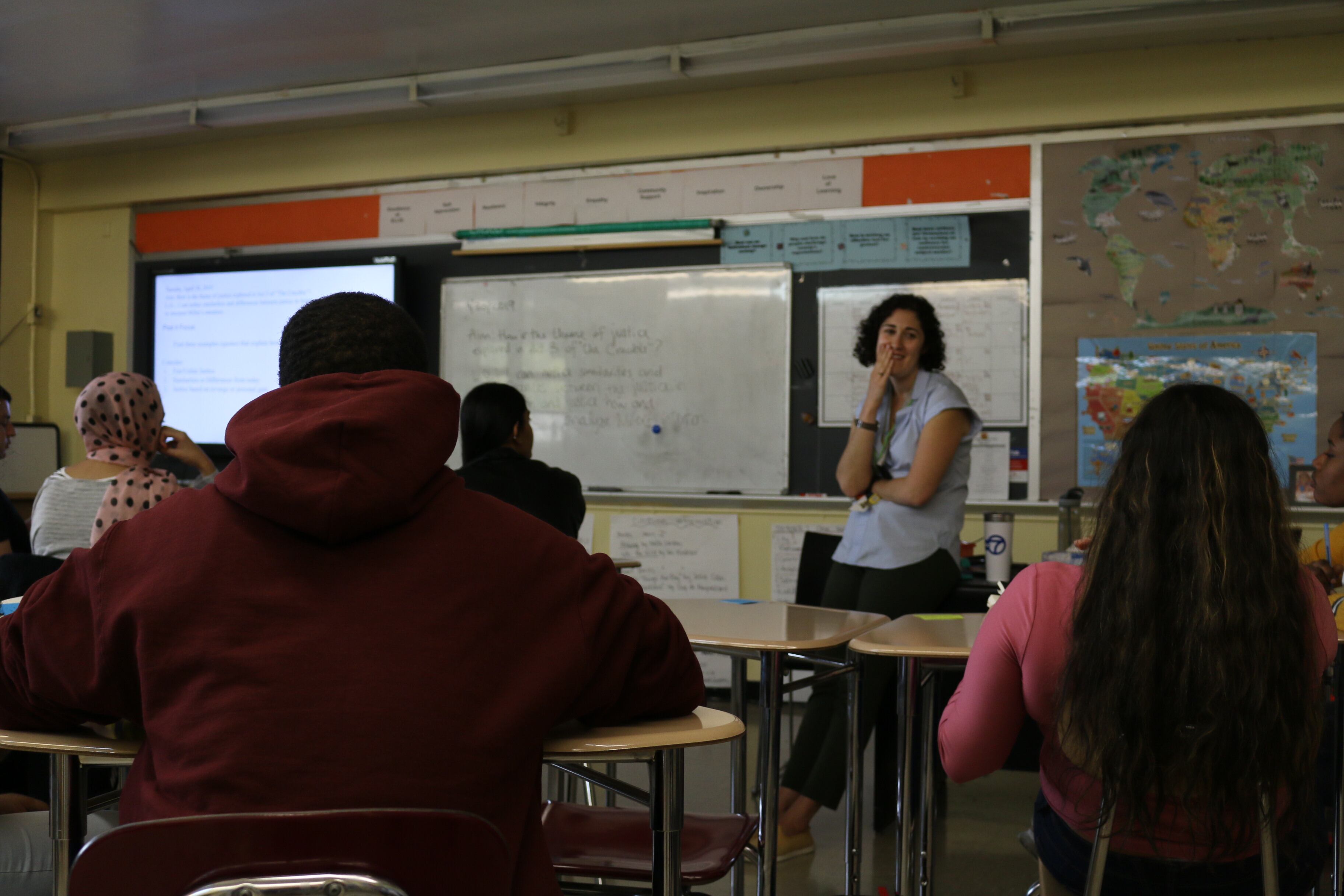Choosing a public high school can be a daunting process for New York City families. But it can be particularly confusing for older students who are new to the United States, speak limited to no English, and in some cases, may have gone years without formal schooling.
For years, immigration advocates have cited those students as they pushed the city to create more school programs tailored to the needs of new immigrants — and this year, they may get their wish.
The Education Collaborative, a coalition of more than 30 community organizations, wants the city to launch a three-year, $8.2 million pilot program that would hire more teachers and bilingual social workers to work with up to 400 more newcomer immigrant students, ages 16-21. Those staff, paired with professional development for current teachers, would be directed to several of the city’s existing transfer schools, which are for students not on track to graduate on time.
“Public schools are in many ways largely inaccessible for thousands of newcomer youth from the ages of 16 and up,” said Andrea Ortiz, senior manager of education policy at the New York Immigration Coalition, which helped draft plans for the pilot.
Every city school must identify and provide extra language services to students learning English as a new language and receive extra funding to do so. However, newcomer immigrant youth often face even more challenges, such as balancing a job with school, than others learning the language. They also report that they don’t receive enough support in learning English at school, or that it’s tough for them to navigate and understand classwork. Advocates point to the city dropout rate as a key indicator of these problems: 16% for English learners last school year, compared with 5% of all students.
Those schools may also lack enough teachers trained in serving English learners or bilingual social workers. And the teens might be refugees or the officially designated Students with Inconsistent/Interrupted Formal Education — meaning that they’re two or more years below grade level in their home language in literacy, math, or both.
There are five transfer schools with more intensive programming for students learning English as a new language. The pilot program would expand that sort of model into Queens, the Bronx, and Brooklyn. Four of the five existing schools are located in Manhattan and one is in the Bronx, even though the majority of newer immigrants ages 14-21 live in the Bronx, followed by Queens and Brooklyn, according to Census data analyzed by the Migration Policy Institute.
“It’s very frustrating and actually quite depressing for us as advocates because we know that when we meet a student who lives geographically far from the [English language learner] transfer schools, we know immediately it is going to be an uphill battle,” said Rita Rodriguez-Engberg, director of the Immigrant Students Rights Project at Advocates for Children New York.
Carolyne Quintana, deputy chancellor of teaching and learning, said the city plans “to increase the number of transfer schools for newcomer [English language learners]” during a town hall meeting last month.
Asked about Quintana’s comments, city officials say they have been working with these advocates and are interested in the idea, as Mayor Eric Adams crafts a budget plan for next fiscal year, which starts July 1.
“Expanded access to high quality transfer school programs for older newcomer students is one way we can meet the needs of students who need alternative forms of education in supportive, welcoming environments,” said Nicole Brownstein, a spokesperson for the education department, in a statement.
Immigrant students face struggle to find right services
Just under 22,000 immigrants ages 14-21 lived in New York City for three years or less — the city’s definition for a newcomer — between 2015 and 2019, according to Migration Policy Institute’s analysis. Nearly 18% of them — or 3,900— were not enrolled in school or had not yet received a diploma or an equivalent. Just 500 of those non-enrolled teens were ages 14 or 15, while the rest were between 16 and 21 years old.
Like any city resident, newly arrived immigrant youth have the right to enroll in school up to age 21. But for many years, advocates have highlighted complaints from their newcomer immigrant clients that they’ve struggled to find a program that fits their needs or is nearby, or both. Sometimes students have reported being told by enrollment staff that they’re too old to enroll and are better off pursuing a GED — a complaint that state officials also received in 2019 about New York City’s enrollment practices.
If the pilot program is established, just over $480,000 would go to each participating school. Among other things, that money would go toward:
- hiring an English as a new language (or ENL) teacher
- a bilingual social worker
- overtime pay for school year and summer planning
- wraparound supports provided by community-based organizations
- professional development so that all teachers at the school can learn how to work with older immigrant students
- student internships
- enrichment for SIFE students
During visits to the five transfer schools focused on students learning English as a new language, Rodriguez-Engberg was struck by how many students said they were glad to have a bilingual social worker who “could help them navigate not just school life but life in the U.S.” Students may be dealing with varying levels of trauma, she said, such as coming to the U.S. alone, leaving conflict behind in a home country, being detained at the border before being released, or just missing home.
Still, the dropout rate is high at those five schools: 29% for English learners on average, or 13 percentage points higher than for English learners citywide.
But Ortiz, from New York Immigration Coalition, noted that these programs tend to serve a higher proportion of high-needs English learners, such as low-income students and those who have not had formal education for multiple years.
In four of the five schools, more than 73% of students are English learners. In two of them, more than 92% are English learners, and at all of the schools, 78% or more students are low-income.
“This is a population that’s being pulled in a lot of directions that often has really real responsibilities — they are oftentimes being pushed to work and support their families — but that doesn’t meant they don’t need a school option or the time they were in school is not worth celebrating,” Ortiz said.
‘I would refer it to everybody’
Georges Remy, who is now 23, graduated from one of the Manhattan transfer schools in 2019, two years after arriving in New York City from Haiti. He felt welcome in the school because there were many students like him who were new to the country. His teachers took time to translate their lessons into various languages, and had an open door policy before and after class to seek out help.

He attended after-school classes, and also credits his guidance counselor who checked in on him throughout the week and encouraged him to pursue an advanced Regents diploma.
“Personally, I would refer it to everybody who comes to the U.S.,” he said.
The pilot program’s effectiveness will rely not just on the hiring of more ENL teachers, but also how well other subject area teachers are trained in serving English learners, said Sebastian Cherng, an associate professor of international education at New York University who has studied the city’s English learners.
The state has previously highlighted the city’s failure to provide enough services for the city’s English language learners in a yearslong corrective action plan to improve how it educates these students.
Last August, state officials told city officials they were “extremely dismayed and disappointed by the overall lack of bilingual education programs,” according to a letter obtained by Chalkbeat through an open records request. The city has also failed to provide legally required bilingual special education services to most English learners with disabilities.
One of the city’s priorities is to boost the 60% graduation rate for English language learners, a department spokesperson said, though her response to a question about the issue from Chalkbeat did not specifically mention older immigrant students. Its efforts to address the issue include building teams of teachers who create a “welcoming environment” for English language learners, and teaching immigrant students about financial aid options and their rights as they figure out life after high school.
While $8.2 million for the pilot program is a start, the city should consider a larger investment, Cherng said.
“It is the last time that many of our young people will experience schooling,” he said. “It has broader implications than just academic stuff, but also a sense of belonging.”
Reema Amin is a reporter covering New York City schools with a focus on state policy and English language learners. Contact Reema at ramin@chalkbeat.org.





